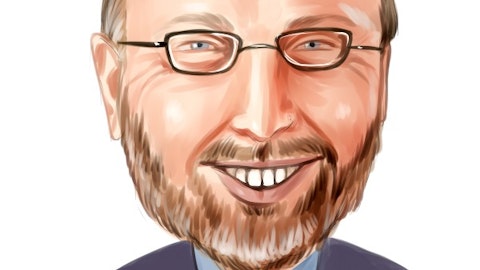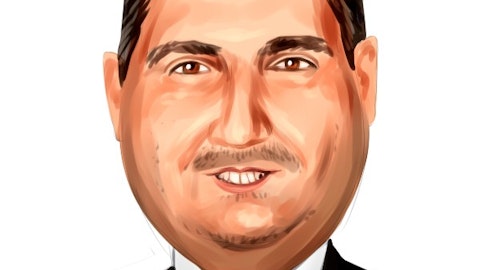Healthpeak Properties, Inc. (NYSE:PEAK) Q2 2023 Earnings Call Transcript July 28, 2023
Operator: Good morning, and welcome to the Healthpeak Properties, Incorporated Second Quarter Conference Call. All participants will be in a listen-only mode. [Operator Instructions]. After today’s presentation there will be an opportunity to ask questions. [Operator Instructions]. Please note this event is being recorded. I would now like to turn the conference over to Andrew Johns, Senior Vice President of Investor Relations. Please go ahead.
Andrew Johns: Welcome to Healthpeak’s second quarter 2023 financial results conference call. Today’s conference call will contain certain forward-looking statements. Although we believe the expectations reflected in any forward-looking statements are based on reasonable assumptions, our forward-looking statements are subject to risks and uncertainties that may cause actual results to differ materially from our expectations. A discussion of risks and risk factors is included in our press release and detailed in our filings with the SEC. We do not undertake a duty to update any forward-looking statements. Certain non-GAAP financial measures will be discussed on this call. In an exhibit of the 8-K furnished with the SEC yesterday, we have reconciled all non-GAAP financial measures to the most directly comparable GAAP measures in accordance with Reg G requirements.
The exhibit is also available on our website at healthpeak.com. I will turn the call over to our President and Chief Executive Officer, Scott Brinker.
Scott M. Brinker: Thanks, Andrew. Good morning and welcome to Healthpeak’s second quarter earnings call. Joining me today for prepared remarks is Pete Scott, our CFO and our senior team is here for Q&A. Last evening, we increased earnings guidance and reported 4.8% blended same store growth. The balance sheet remains in great shape. Through streamlining and automation Our G&A for 2023 is expected to be 6% below our original 2022 guidance. We’re operating in a volatile macro-environment where we have a strong handle on the things we can control. Fundamental driver of demand for our real estate is the desire for improved health, which is only growing. Equally important, we benefit from the impact of technology across our playing field of medical discovery and delivery.
For example, Progressive Health Systems now have 10 plus outpatient locations for every one hospital, with a strategic plan to grow that ratio to 20 plus. The hospital remains the epicenter, but much of the growth as outpatient is made possible by technology. The shift in delivery aligns with our strategy to capture the outpatient real estate needs of leading health systems. And with tighter profit margins because of the cost of labor, health systems will increasingly seek knowledgeable third party capital like Healthpeak to expand their footprint. Similarly, technology will reinforce and expand the need for lab space. AI and machine learning will increase the probability of success in drug research and reduce development timelines. This will drive more capital into the sector.
The data needed for the algorithms and the validations comes from the laboratory, which are highly regulated and controlled environments. A Nobel Laureate in chemistry recently said that she’d run her lab for 30 years, and never experienced the accelerating discoveries we’ve seen in just the last five years alone. The science is building on itself, including our understanding of genetics and improved testing, which will transform healthcare delivery. Today, it’s reactive, we seek therapeutics after a problem arises, technology will drive the addition of proactive care where we detect issues and seek care before a problem arises. This will shift the allocation of healthcare spending and expand the total pie. Our outpatient medical and lab buildings will be a critical part of this future.
A few comments on portfolio performance starting with outpatient medical where we have an irreplaceable portfolio and deep relationships with leading health systems. More than half of our square footage is now leased directly to a health system, which is 2X the level from 20 years ago as their business model has shifted towards outpatient care, and we’ve become a partner of choice. I toured a number of our buildings in recent months and saw very active parking lots and lobbies, a great sign for current and future leasing. Our concentration in high growth markets like Dallas, Houston, Phoenix, Vegas, and Nashville will benefit our portfolio for the next decade plus. Moving to our lab business where we have significant market share in key sub markets, a diversified tenant base, and strong relationships.
Biotech’s have been doing what they should do in this environment, which is to conserve cash. So the default answer has been to make do with existing space. That mindset made perfect sense the past few quarters but will naturally run in cycles. Despite that backdrop, we’ve had solid leasing activity, primarily with existing portfolio tenants who accounted for 89% of year-to-date leasing. In each case, the broader market either isn’t seeing the prospect, or is it a big disadvantage because we can tear up an existing lease in exchange for a larger, longer-term commitment. More recently, we’ve seen an uptick in leasing discussions, which may reflect the more benign outlook for the Fed and interest rates. I’ll close with transactions. The market remains slow given the financing markets and inactivity from core funds and non-traded REITs, many of which have redemption queues.
Despite that backdrop, we’ve sold $130 million of fully stabilized but less core real estate year-to-date, at an attractive 5.4% cap rate and use the proceeds to accretively delever. We’re currently having good discussions on a couple $100 million of additional less core asset sales. Subject to closing, which isn’t guaranteed in this environment, we’ll have flexibility to either accretively pay down our line of credit or buy back stock. I will turn it to Pete to cover financial results, balance sheet, and guidance.
Peter A. Scott: Thanks, Scott. For the second quarter, we reported FFO’s was adjusted of $0.45 per share, AFFO of $0.40 per share, and total portfolio same store growth of 4.8%. In addition, our Board declared a dividend of $0.30 per share, which equates to an AFFO payout ratio of approximately 75%. Let me provide a little more color on segment performance. Starting with CCRCs, same store growth for the quarter was a very strong 19.3%. Occupancy has increased 230 basis points year-over-year and we see additional upside with zero new supply in our markets. Total NREF cash receipts were $31 million in the quarter and for the full year we expect our cash receipts to exceed NREF amortization by 5 pennies per share. Turning to outpatient medical, we had another solid quarter with same store growth of 2.5%.
Demand for our space is high and leasing momentum remains strong. We have executed 83% of our full year leasing budget and have an additional 15% in documentation. Re-leasing spreads were up 3.7% during the quarter, which again was at the high end of our historical 2% to 4% range. Trailing 12-month tenant retention was 81% which is a reflection of the quality of our assets and our time tested platform, which consistently produces sector leading customer satisfaction scores. Finishing with lab. Same store growth for the quarter was 3.8%. Year-to-date we have executed 461,000 square feet of leases, approximately 90% of that leasing activity has been with existing tenants, and we achieved positive re-leasing spreads of 52% on renewals. In addition, we have another 196,000 square feet of executed LOI with the majority of that activity occurring in July.
All of our LOIs are with existing tenants, which further demonstrates the superior advantage that incumbent property owners like Healthpeak have in their respective markets. With the Biotech index up 10% since the start of the second quarter, we are seeing an increase in tenant capital raising activity. Equity markets are open for companies with positive data readouts. Venture capital investment increased over $1 billion sequentially with Series A rounds growing more popular. M&A continues with $80 billion of deals announced year-to-date. The IPO market is showing signs of life and reverse mergers are becoming more popular, providing an alternative for companies to go public. An important part of our lab strategy is proactive asset management to improve our tenant credit profile.
As we had previously announced, we downsized Adverum in favor of Revolution Medicines trading a small cap credit for a $3 billion market cap company. During the second quarter we backfilled the significant portion of the Kodiak space to Lonza Bioscience and Bicycle Therapeutics. In both cases a significant credit upgrade. And at the cove, we proactively facilitated an assignment of the Harpoon Therapeutics lease to a private Biotech. A quick note on Sorrento Therapeutics. We’ve been paid rent in full through July on the four operating leases, and we hold letters of credit or security deposits of $2.6 million, so no impact on 2023 earnings regardless of the outcome. As you’ve probably seen, Sorrento was working on an exit financing package, but at this point, there are no details I can provide or assurances it will be completed.
We hope to have clarity on a path forward in the near-term. Turning now to our balance sheet. In May, we issued $350 million of 5.25% fixed rate bonds bringing year-to-date issuance to $750 million at a blended yield of approximately 5.35%. Our net floating rate debt balance was approximately $150 million at quarter end. Our balance sheet continues to be a competitive advantage in this environment. Our net debt to EBITDA is 5.1 times with nearly $3 billion of liquidity. We have net floating rate debt exposure of approximately 2%. We have no bonds maturing until 2025. We have approximately $150 million of annual retained earnings and we have stable ratings from both S&P and Moody’s. Our development spend is self-funded without the need for equity or asset sales from a combination of retained earnings and debt capacity from higher EBITDA.
As Scott mentioned, any potential asset sales would be opportunistic and are not contemplated in guidance. Turning now to our 2023 guidance, we are increasing our FFOs adjusted and AFFO guidance by 1 penny at the midpoint to $1.75 and $1.51, respectively. As you can see from our year-to-date results, performance across our portfolio remains strong, and we are increasing our full year blended same store guidance range by 25 basis point to 4% at the midpoint. Please refer to Page 38 of our supplemental for additional detail on our guidance. With that operator, lets open the line for Q&A.
See also 26 Biggest Marijuana Companies in the World and 20 Most Visited Countries in Asia.
Q&A Session
Follow Healthpeak Properties Inc. (NYSE:DOC)
Follow Healthpeak Properties Inc. (NYSE:DOC)
Operator: Thank you. [Operator Instructions]. And our first question comes from Juan Sanabria from BMO Capital Markets. Please go ahead.
Juan Sanabria: Good morning. Scott or Peter, I was just hoping you could talk a little bit more about the Life Science or lab market and the increase you’ve seen in demand in July and how if you can maybe characterize or put a number around the increase in kind of opportunities or number of companies looking for space or the amount of space being sought after by potential tenants and how and what has changed?
Peter A. Scott: Yeah. Hey, Juan, it’s Pete. Hopeful as well. Maybe I’ll just start with that and perhaps Scott Bohn or Scott Brinker wants to add a little bit to it. But, we talked about this earlier in the year that our tenant credit risk profile has been improving in the lab space. We also saw that sequentially this quarter as well. And I don’t want to repeat a lot of what I said in my prepared remarks but a lot of that improvement in the credit profile is because the capital markets are improving as well. Just a couple of stats when you think about follow on equity deals, you’ve had about $14 billion of deals get done year-to-date, tenants that have good data readouts are finding success raising capital. You look at the venture capital market and that has improved.
It’s improved $1 billion sequentially. And in fact, we’re seeing more Series A capital raises as it occurs as well, which is important because that’s really new company formation and that beat demand for new space for us. M&A is strong, in fact, that was another M&A deal that got announced this morning. So that $80 billion is actually more like, 87 billion at this point in time. And then, reverse mergers are definitely popular right now so it’s a backwards way of companies going public. We saw that in our portfolio with frequency merging with [indiscernible]. So, I’d say really that’s what’s driving the improved backdrop. Obviously there’s other things going on at each individual market. But we feel like things are trending in the right direction for us, and has certainly led to a little bit more leasing demand, as you saw the LOIs that got signed in July.
And we hope that that’s a harbinger for more to come in the next couple of quarters. But again, feeling a little bit better today than we did six months ago.
Juan Sanabria: And then just our follow-up question, just on the MOB guidance bump, what was the driver that the second quarter seemed solid, but within I guess the typical range, just curious on what drove the increased confidence there?
Thomas M. Klaritch: Yeah, Juan this is Tom. We continued to see positive operations at Medical City, Dallas, and that contributed about 90 basis points for the year and 50 basis points for the quarter. In addition, our escalators remain at that kind of 2.93% range. So that’s driving results and we continue to see rebounds in parking income where we’re above our pandemic level reduction. So that continues to drive our results. And as you said, the 2Q was really solid at 2.5%. And that was even with some headwinds against it. We had some — a fairly high comp in 2Q of 2022 at 4.5% and that included some adjustments in rent abatements and we had some positives to our expense reconciliation billings. So that had about a 70 basis point impact. We would have been at about 3.2% 2Q without those.
Juan Sanabria: Thank you guys.
Operator: The next question comes from Vikram Malhotra from Mizuho. Please go ahead.





